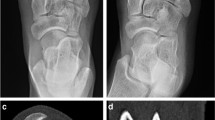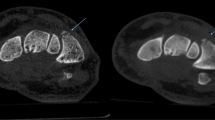Abstract
Background
The aim of the study was to evaluate whether ultra-low-dose computed tomography (ULD-CT) could replace conventional-dose CT (CD-CT) for diagnosis of acute wrist, ankle, knee, and shoulder fractures in emergency departments (ED).
Methods
We developed CD-CT and ULD-CT scanning schemes for the various joints of the four limbs and scanned emergency patients prospectively. When performing CD-CT, a conventional bone reconstruction algorithm was used, while ULD-CT used both soft tissue and bone algorithms. A five-point scale was used to evaluate whether ULD-CT image quality affected surgical planning. The image quality and diagnostic performance of different types of scanned and reconstructed images for diagnosing fractures were evaluated and compared. Effective radiation dose of each group was calculated.
Results
Our study included 56 normal cases and 185 fracture cases. The combination of bone and soft tissue algorithms on ULD-CT can improve diagnostic performance, such that on ULD-CT, the sensitivity improved from 96.7% to 98.9%, specificity from 98.2% to 100%, positive predictive value from 99.4% to 100%, negative predictive value from 90.2% to 96.6% and diagnostic accuracy ranged from 97.5% to 99.1%. There were no statistically significant differences between ULD-CT and CD-CT on diagnostic performance (p values, 0.40–1.00). The radiation doses for ULD-CT protocols were only 3.0–7.7% of those for CD-CT protocols (all p < 0.01).
Conclusions
In the emergency department, the 320-row detector ULD-CT could replace CD-CT in the diagnosis of limb joint fractures. The combination of bone algorithm with soft tissue algorithm reconstruction can further improve the image quality and diagnostic performance.



Similar content being viewed by others
Abbreviations
- CT:
-
Computed tomography
- DR:
-
Digital radiography
- ULD-CT:
-
Ultra-low-dose CT
- CD-CT:
-
Conventional dose CT
- ED:
-
Emergency department
- DLP:
-
Dose-length product
- SD:
-
Standard deviation
- ROI:
-
Region of interest
- CNR:
-
Contrast-to-noise
- SNR:
-
Signal-to-noise
- PPV:
-
Positive predictive value
- NPV:
-
Negative predictive value
- ICC:
-
Intra-class correlation coefficient
References
Guly HR. Diagnostic errors in an accident and emergency department. Emerg Med J. 2001;18(4):263–9.
Cuddy K, et al. Use of intraoperative computed tomography in craniomaxillofacial trauma surgery. J Oral Maxillofac Surg. 2018;76(5):1016–25.
Matsuoka S, et al. Three-dimensional computed tomography and indocyanine green-guided technique for pulmonary sequestration surgery. Gen Thorac Cardiovasc Surg. 2021;69(3):621–4.
**a H, et al. Application of rib surface positioning ruler combined with volumetric CT measurement technique in endoscopic minimally invasive thoracic wall fixation surgery. Exp Ther Med. 2020;20(2):1616–20.
Morshed S, et al. Outcome assessment in clinical trials of fracture-healing. J Bone Joint Surg Am. 2008;90(Suppl 1):62–7.
Larson DB, et al. National trends in CT use in the emergency department: 1995–2007. Radiology. 2011;258(1):164–73.
Azman RR, Shah MNM, Ng KH. Radiation safety in emergency medicine: balancing the benefits and risks. Korean J Radiol. 2019;20(3):399–404.
Griffey RT, Sodickson A. Cumulative radiation exposure and cancer risk estimates in emergency department patients undergoing repeat or multiple CT. AJR Am J Roentgenol. 2009;192(4):887–92.
Alagic Z, et al. Ultra-low-dose CT for extremities in an acute setting: initial experience with 203 subjects. Skeletal Radiol. 2020;49(4):531–9.
Hamard A, et al. Ultra-low-dose CT versus radiographs for minor spine and pelvis trauma: a Bayesian analysis of accuracy. Eur Radiol. 2021;31(4):2621–33.
Weinrich JM, et al. MDCT in suspected lumbar spine fracture: comparison of standard and reduced dose settings using iterative reconstruction. Clin Radiol. 2018;73(7):675 e9-e15.
Saltybaeva N, et al. Estimates of effective dose for CT scans of the lower extremities. Radiology. 2014;273(1):153–9.
Brenner DJ, Hall EJ. Computed tomography–an increasing source of radiation exposure. N Engl J Med. 2007;357(22):2277–84.
Lin EC. Radiation risk from medical imaging. Mayo Clin Proc. 2010;85(12):1142–6.
Yi JW, et al. Radiation dose reduction in multidetector CT in fracture evaluation. Br J Radiol. 2017;90(1077):20170240.
Mansfield C, et al. Optimizing radiation dose in computed tomography of articular fractures. J Orthop Trauma. 2017;31(8):401–6.
Konda SR, et al. Ultralow-dose CT (reduction protocol) for extremity fracture evaluation is as safe and effective as conventional CT: an evaluation of quality outcomes. J Orthop Trauma. 2018;32(5):216–22.
**ao M, et al. Application of ultra-low-dose CT in 3D printing of distal radial fractures. Eur J Radiol. 2021;135:109488.
Brink M, et al. Single-shot CT after wrist trauma: impact on detection accuracy and treatment of fractures. Skeletal Radiol. 2019;48(6):949–57.
Halvachizadeh S, et al. Is the additional effort for an intraoperative CT scan justified for distal radius fracture fixations? A comparative clinical feasibility study. J Clin Med. 2020;9(7):2254.
Elegbede A, et al. Low-dose computed tomographic scans for postoperative evaluation of craniomaxillofacial fractures: a pilot clinical study. Plast Reconstr Surg. 2020;146(2):366–70.
Konda SR, et al. The use of ultra-low-dose CT scans for the evaluation of limb fractures: is the reduced effective dose using ct in orthopaedic injury (REDUCTION) protocol effective? Bone Joint J. 2016;98B(12):1668–73.
Author information
Authors and Affiliations
Corresponding author
Additional information
Publisher's Note
Springer Nature remains neutral with regard to jurisdictional claims in published maps and institutional affiliations.
About this article
Cite this article
Lei, M., Zhang, M., Li, H. et al. The diagnostic performance of ultra-low-dose 320-row detector CT with different reconstruction algorithms on limb joint fractures in the emergency department. Jpn J Radiol 40, 1079–1086 (2022). https://doi.org/10.1007/s11604-022-01290-1
Received:
Accepted:
Published:
Issue Date:
DOI: https://doi.org/10.1007/s11604-022-01290-1




